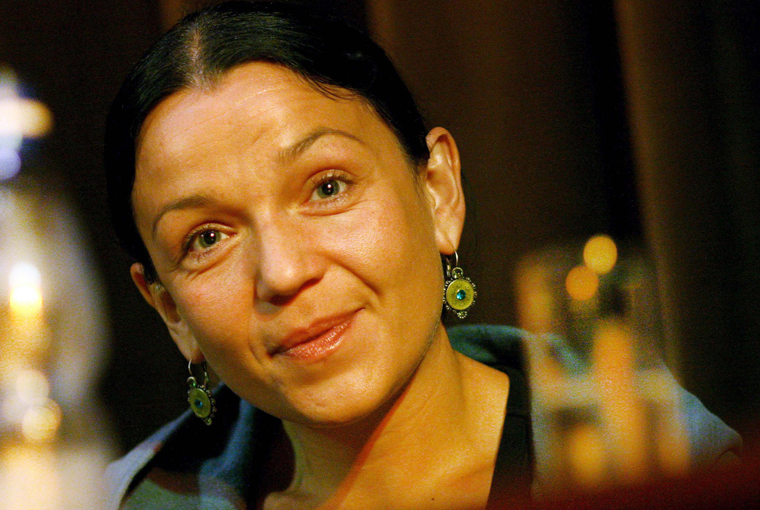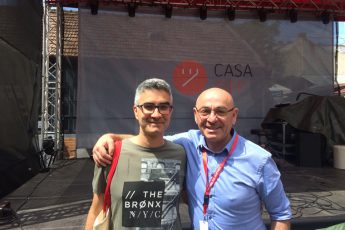
At the Filmfestival Cottbus, we caught up with Joanna Kos-Krauze who co-directed “Papusza” with Krzysztof Krause. The film, which follows the life of Roma poet Papusza, screened in-competition. Kos-Krauze speaks about her career, making “Papusza”, and her interaction with Romani culture.
I want to ask you a lot about the film, but may I ask first about your background? Did you do film studies?
No, not at all. I studied Polish and Hebrew for two years. Then I started working for the Lauder Foundation, established by Estée Lauder’s son to rebuild the Jewish community. I spent a lot of time in America and Israel. After that I started to work for Polish TV. They had announced some kind of scholarship for people to write screenplays, and I won. Later on, I went into the film industry.
TV was fantastic because we started to write a screenplay, and then they gave us the camera and materials. It was the best school. I worked for them for a few years. Then I worked for a Dutch company which had opened a branch in Poland for commercial TV. Slowly, I moved into the film business because I knew that pure entertainment is not for me.
And how did your collaboration with Krzysztof Krauze [co-director of “Papusza”] start?
First I helped him with a script for the movie The Debt. Then we wrote a script together based on my idea. And after that we made a political movie. We knew that we want to make something completely different. This was My Nikifor [Mój Nikifor, 2004], about the naive painter. It’s about the roots of art and talent. It was very successful. Then we made a kind of triptych of films for Polish TV. Then came Savior’s Square [Plac Zbawiciela, 2006] and Papusza and in March we start our next shoot in Poland and Rwanda for a film about the genocide. Or rather, it’s a psychological movie about how to live after genocide…
So you and your husband seem very interested in stories about artists who have dealt with trauma. “Papusza” is an artist who lived through the most terrible times of the twentieth century.
The Polish Roma community’s past is absolutely tragic. First, they suffered a lot during the Second World War as a minority. The Nazis killed almost all of them. Then after the war, in Central-Eastern Europe, they were forced to settle down, because the Communist regime had forbidden them to travel. For us Poles Papusza is also the legend of the “cursed poet.” Everyone has heard something about her, but nothing is for sure… So it was a good thing to reveal part of her world which has disappeared from the European landscape. You can’t see traveling gypsies anymore. The wagons have stopped forever.
You said during the Q&A that the actors had to learn a Romani dialect which doesn’t exist anymore…
It exists, but it’s really, let’s say, impure. That’s the problem. Polish people in America don’t speak the pure Polish language anymore, they put English endings on Polish roots. It’s like that. So we had to reconstruct this pureness of style. But a version of the Polish Roma dialect is still spoken.
How did you go about reconstructing the dialect? Did you have researchers working with you?
We had a language consultant. We didn’t do it by ourselves!
Did you get help from Romani associations with the historical details and the research?
No, because the Romani in fact didn’t have historians. This is also tragic for the Romani people. Almost all that was written and published is by Polish authors, because the Romani — especially before the Second World War, but even into the late seventies and eighties — didn’t believe in education. It was their lifestyle, a spoken culture. So even Ficowski, who published Papusza’s poems and the first monographic books on the Gypsies, was Polish! Then other Poles started writing books about the culture. Bit by bit it appeared from the Gypsies themselves, and they now have an intellectual written culture.
You said only three of the actors were non-Romani.
Yes. The actress playing Papusza [Jowita Budnik] was Polish, as was the actor playing her husband [Zbigniew Walerys] and Antoni Pawlicki, who played Ficowski.
Were the Romani actors professional?
None of them were.
What was it like working with them? Does it still feel like they are a culture apart?
No, it was really easy. Of course, they still have a very strong code — it’s called marime. You have to know how to behave in some situations. So for example, the very old men, who are respected in the society, didn’t want to listen to me because I am a woman and younger than them. So Krzysztof had to give the directions. But that was at the beginning. I should say that old women, on the other hand, are very respected.
That’s something I found very fine about the film. It doesn’t gloss over problems in the gypsy community of the time — the fact that Papusza was married at fifteen to a much older man, and that she suffered in some ways for being a woman — but there’s no condemnation of the society either. It’s very nuanced.
We were even a little bit afraid of the reaction of the Roma people, because we were not idealizing the community. They are very patriotic, they do not always like strangers sometimes and they have strict codes about some things. We wanted to show an honest view of this society. It’s very difficult, especially for women.
How was the Romani reaction to the film been?
Super. Because it’s the first time the community in this part of Europe has received a sort of historical “fresco” treatment. As I mentioned yesterday, we absolutely did not want to make a typical biography. We wanted to show a few of the most important, deciding moments of their history in the twentieth century.
You used the word “fresco”, which is very interesting with regard to the way you used photographs as backdrops.
That’s why it’s not a linear structure. What we really wanted to avoid was the American-style three-act structure, wherein everything is so Hollywood — no, no, no. We hate this! And what we wanted to use is an emotional structure, when you are recalling something to yourself, you have a flashback, maybe for five seconds or for five minutes, and you don’t know why. So that’s why the film is difficult to watch for some people. They are confused because we are so used to linear structure, where everything has to be clear and step-by-step.
Do you think the film is following Papusza’s emotional structure, even though it depicts her whole community?
Yes. It’s from her remembrance of what she survived as a kid and as a young woman.
How long did the whole post-production process take?
Not very long. The longest process was to make a soundtrack, because we had to reconstruct everything. Sound designers now tend to buy everything from sound databases. They can buy, say, birdsong… But nobody knows what the sounds of a small town in the 1920s would have been like, so we tried to produce it ourselves. Also, for production, they had to build everything. Plus, we had the whole second crew who was shooting on greenscreen. But the whole post-production process was about three months, not so long.
Was it easy to find funding for the film?
Now, in Poland, we have quite a stable system of funding for cinematography. We have the Polish Film Institute, from which you can receive half of the budget of a feature film. Then we received money from Polish TV and Canal Plus. Finally we had some money from distributors. It wasn’t very complicated, in fact.
I’ve been noticing in the news a great presence of Polish film at film festivals. “Papusza” won a Special Mention at Karlovy Vary, no?
At Karlovy Vary, yes, and best director and best actor for Walerys in Valladolid.
Are there many more festivals to go?
About 300.
Wow!
Oh, it’s not that impressive. All over the world, there are five thousand seven hundred something film festivals. Now it’s a lot easier to go to festivals than to collect money for making movies!
Thank you for the interview.




Leave a Comment